RØDECaster Duo is a compact and affordable box of tricks for all your broadcasting needs
A downsized RØDECaster for the masses – will the Duo be as impressive as the larger Pro II?
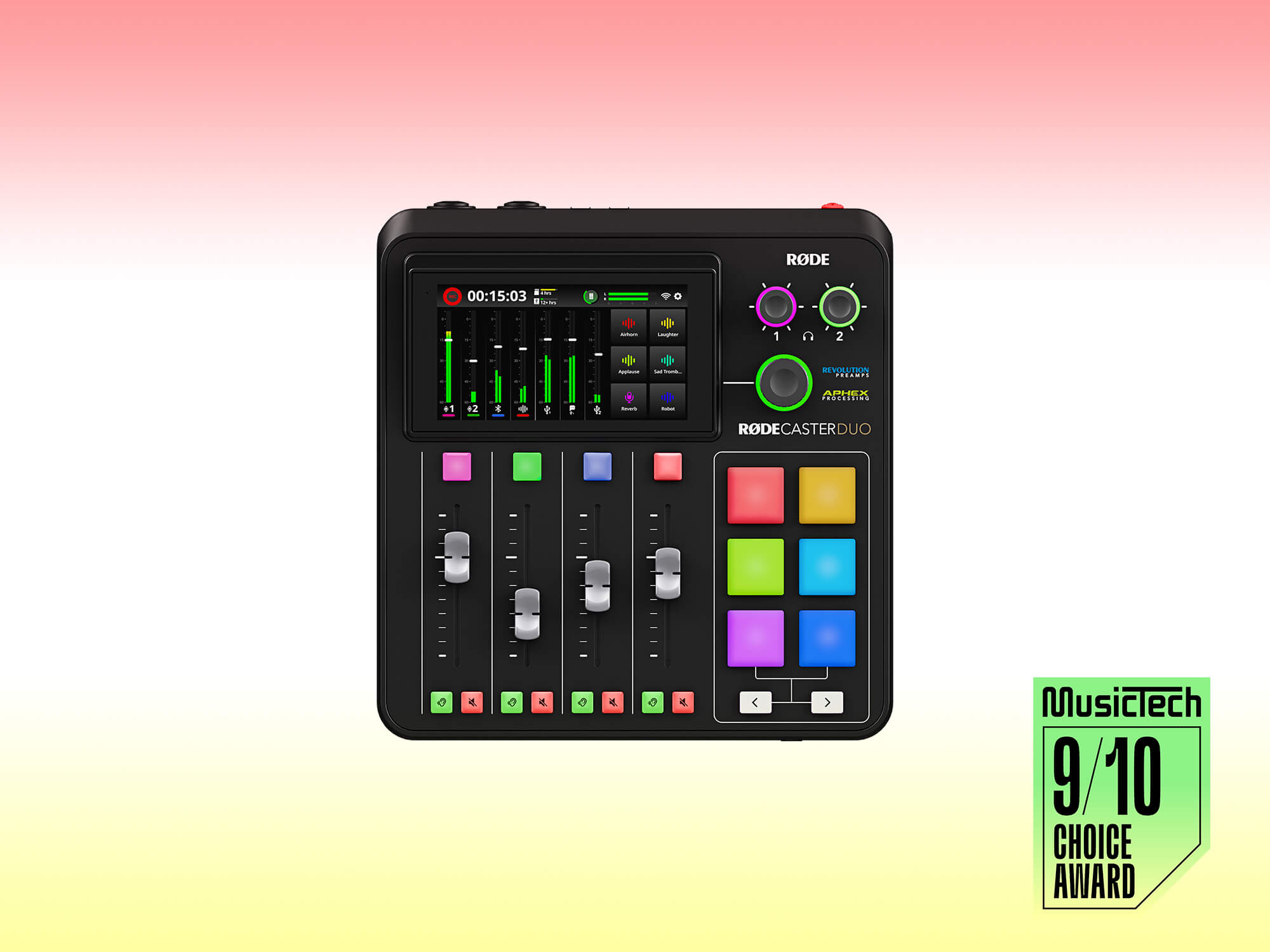
RØDECaster Duo
Review Overview
Our rating
9
Our verdict
⊕ Attractive price
⊕ Reliable build and responsive touchscreen
⊕ Intuitive user interface for beginners and seasoned pros alike
⊕ Incredibly useful touchpads
⊕ Comes with USB cables
⊖ Preamps a little hissy
⊖ Reverb doesn’t sound nice
⊖ Currently no option to duck audio playback from pads under the host mic
$499, rode.com
The original, fully fledged RØDECaster Pro is a mixer and recording device that’s a one-stop solution for content creators. Colourful and hugely capable, we covered its most recent iteration in our September 2022 review.
- READ MORE: Majority’s Teton Plus raises the bar for what an entry-level home AV system should aspire to
For many though, the full-size Pro is overkill, especially as many podcasts are a solo affair or a conversation between two presenters with the second person often working remotely. And this is where the RØDECaster Duo comes in.
Part of RØDE’s huge 2023 product drop, the new Duo distils the essential functions of its larger sibling into a more compact and affordable package. With its bank of faders, visually-appealing screen and touch pads, the Duo still looks and feels the part, while taking up less space on the desk or tucked away in a bag for work on the move.
The four mic preamps of the Pro are reduced to two on the Duo, there are two headphone preamps instead of four, plus slightly fewer faders and pads. Just like the Pro, there remains the option to record directly to an on-device memory card or external drive to make the most of the tactile nature of the device. Plus, there’s a wide selection of ways to incorporate audio from other devices, using Bluetooth, multiple USB audio streams and even to receive signals from RØDE’s own wireless mics. Clever stuff.
Unboxed
Handling the Duo, everything feels and looks great. The included USB-C power supply has a chunky, long cable, while all the physical controls feel tough – before plugging it in, we wonder whether the pads will do anything at all when pressed, such is their lack of give. Turned on, it’s tastefully lit up (you can customise colour-coding if you wish), the touchscreen has really decent resolution and is more responsive than you’d expect on a device at this price. Rotary encoders for controlling volume and other parameters feel a little toy-like, but aren’t at all flimsy in use.
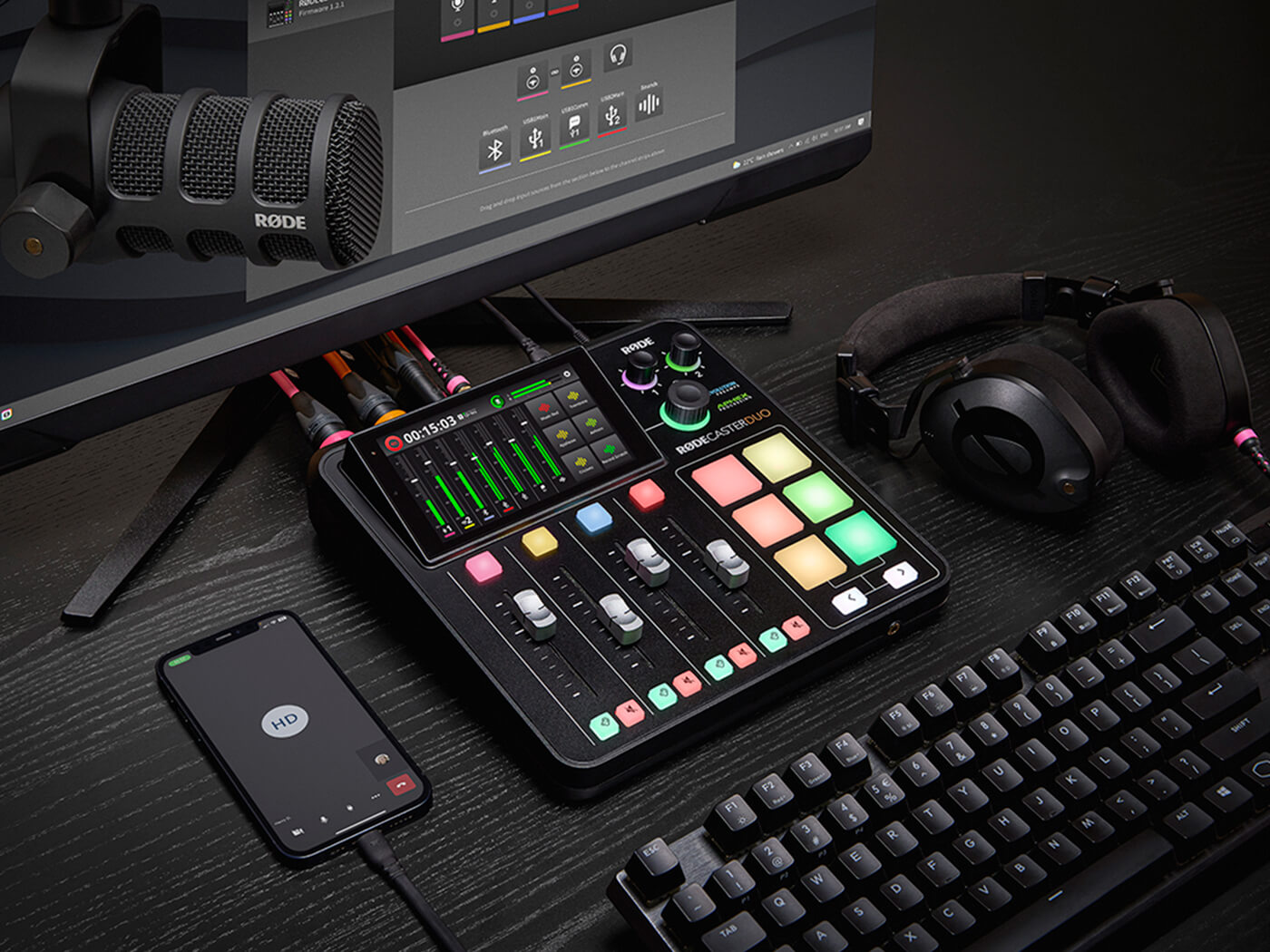
Show time
In session, the Duo is remarkably intuitive to use and, despite the online user guide seeming daunting before we get going, any such fears quickly fade away. There’s a lot to it but it’s so simple to get everything set up and then use it in the high-pressure environment of a live broadcast, even if you’re new to this kind of device. It’s truly liberating how much can be done on hardware, without reference to a glaring, distracting computer screen – much like the digital portastudio of old, but with far fewer barriers when you decide it’s time to chuck material across to the computer for an edit or a brush-up.
Show set-up begins with the preamps, where you select the type of input (mic, line or instrument) and even the model of mic you’re plugging in. According to the choice made, the system sets an appropriate level of gain and tweaks a few EQ and dynamics settings, shaping the incoming signal so it’s closer to the eventual finished product. It’s very handy for novices, then, but more seasoned users might prefer to start with a generic ‘Dynamic’ or ‘Condenser’ starting point and set up their own processing from there. We tend to start with the preset settings based on our Shure SM7B, and then back off the more extreme or unnecessary parts of the processing chain.
Just like other devices that run the preamp signal through various effects, there’s always a trade-off with noticeable self-noise, although the noise gate soon puts pay to this. Therefore, the Duo is not as suited to recording quiet, sensitive music in a studio, but that’s not really what the product is intended for.
The onboard headphone amps crank very loud – we don’t once struggle to hear our Shure SM7B microphone in detail, as we do on some audio interfaces. There’s also a sensitivity setting, which makes the output suitable for either low or high-impedance headphones – a neat touch.
Switched to multitrack mode and linked to a computer, the RØDECaster can be used like a more conventional audio interface, even with the additional option of printing the onboard DSP effects to the recorded track. With an electric guitar plugged in, we test out the DI input running with software monitoring switched on and an amp sim plugin inserted on the track, and the level of latency is acceptable for playing through.
The RØDECaster is more than just a podcasting device. It could be a neat addition to the home recording studio, providing comforting EQ and effects to the performer’s headphones, even if these effects aren’t being recorded.
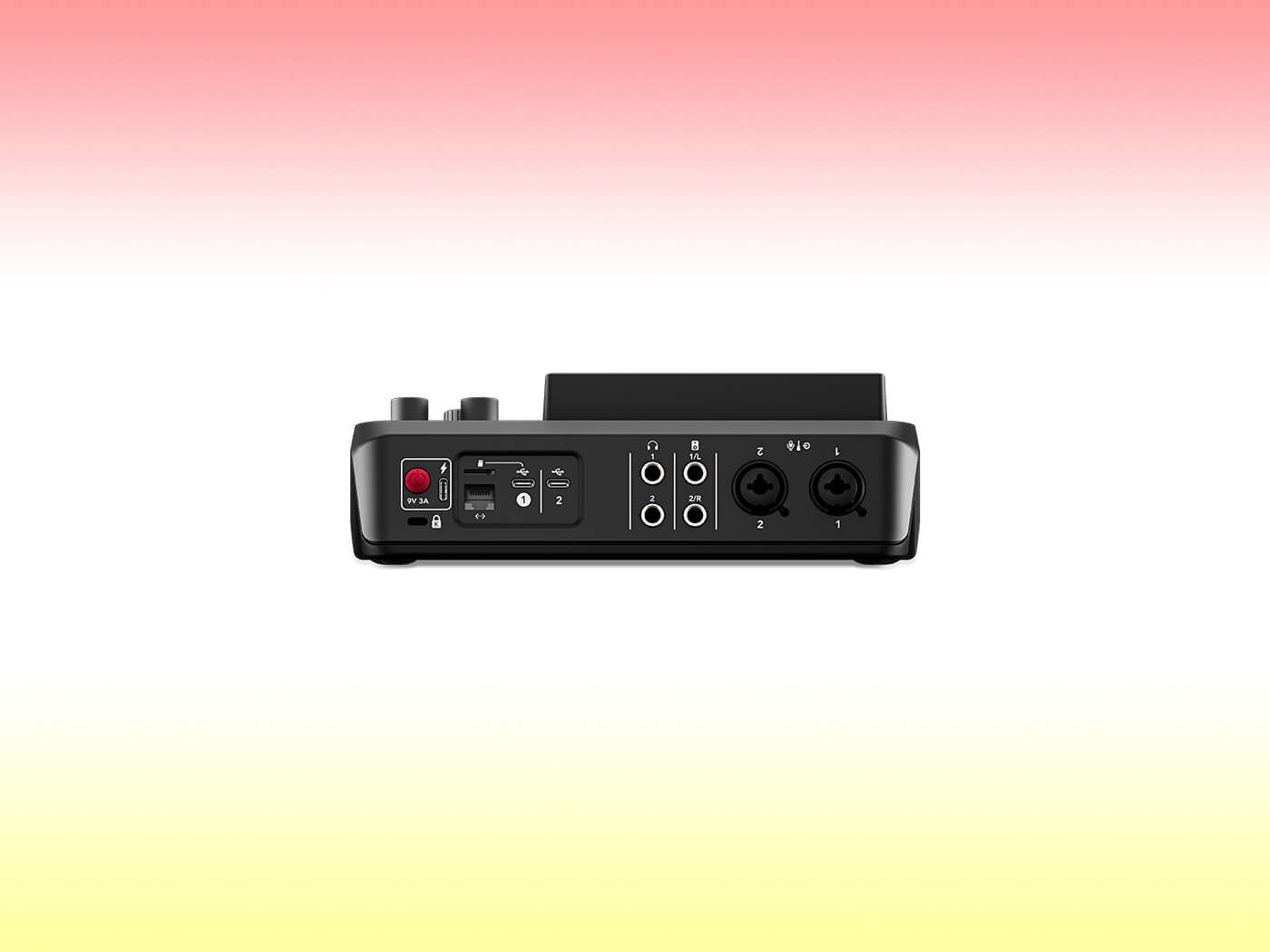
The full effect
Effects are plentiful and offer detailed control over parameters, unlike products lower in the range (such as the PodMic USB, which lacks a proper EQ section). There are thoughtful graphics too – for example, a real-time graph tracking the opening and closing of the noise gate. Again, unexpected at this price point. It’s a shame there are no amp simulators on board for bringing DI’ed electric guitars to life – this is something that some of the Duo’s closest competitors do have.
Speaking of the gate, this cleans things up nicely without being obviously intrusive, typically only requiring a moderate amount of range to get rid of unwanted background noises – very handy for recording in a less-than-ideal environment. Compression and EQ is flattering; in fact, once you’ve got used to it and then turn it off, everything reduces to a hissy, far weaker signal. In a similar way, the exciter section provides harmonic richness in low mids as well as the more typical high frequency sheen.
Further down the line, there’s also a master limiter which seems to be on by default when creating a new ‘show’ – this helps to make everything sound radio-friendly, but its presence did catch us out slightly! There’s reverb, delay and some voice-changing effects too, but as is often the case, the reverb sounds pretty terrible, so that effectively limits the use of the RØDECaster in mixing a musical performance, as opposed to spoken voice.
There’s latency in the monitored preamp signal that does take a bit of getting used to, just in the way that the phase/tonality of the mic’d voice comes across a little strange when you’re also partially hearing the acoustic signal outside of the cans. Adding effects obviously doesn’t help with latency but actually, once you’ve got a gate switched on a compressor pumping up the signal you tend to focus only on the signal running through the mic, so it becomes far less noticeable.
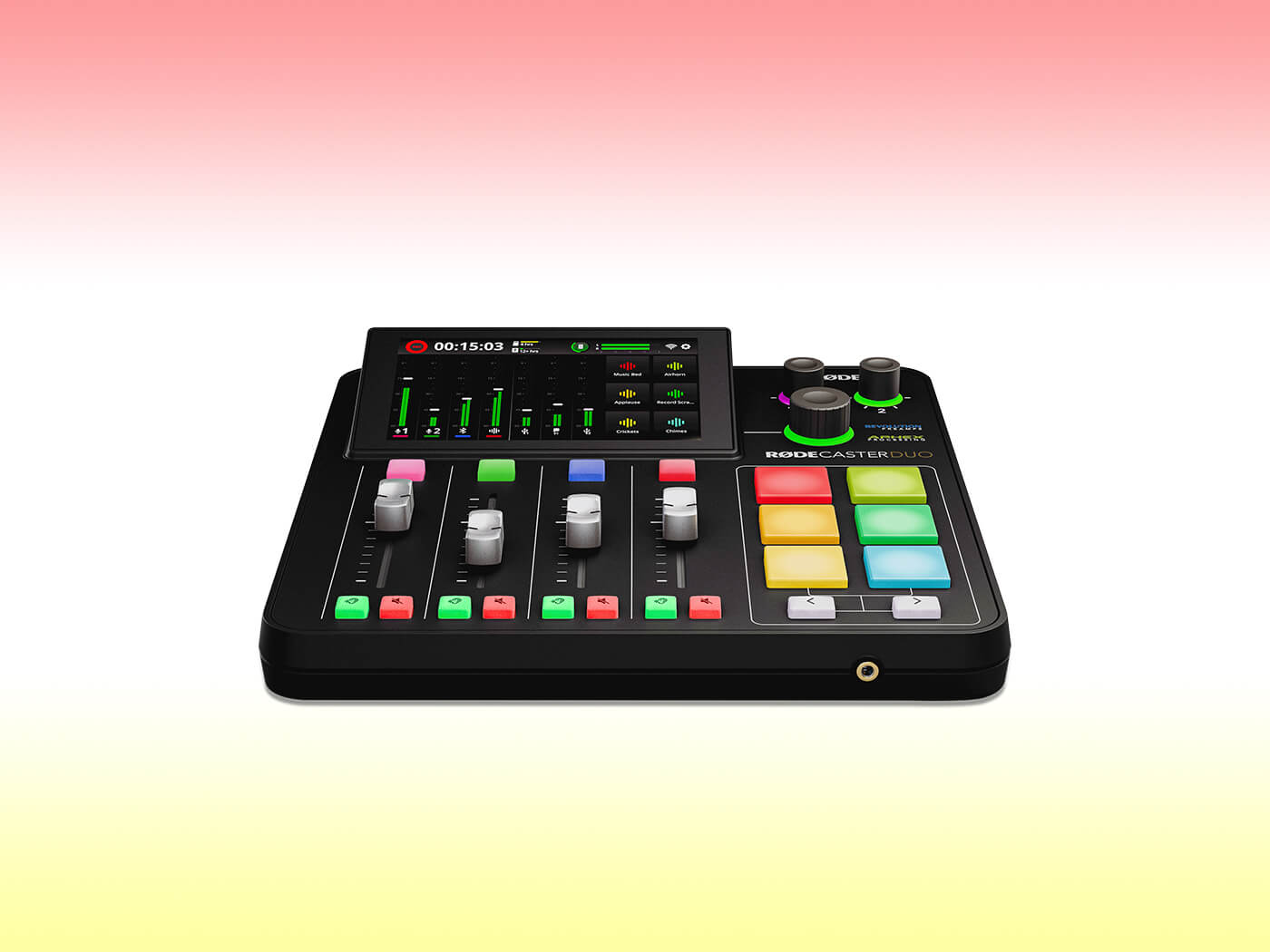
There’s endless fun to be had with the pads. Setting up and using them is a breeze, and in a show situation the most useful functions to reach for are playing back a music bed, triggering sound effects and when things get heated, the censorship bleep. Momentary and latching options are available as well as different playback modes; you can also trim and fade audio, but for some reason the playback button on this screen doesn’t seem to work in the current firmware version.
The ducking function is really handy when talking over an incoming track on the Bluetooth stream or similar (the Mic 1 signal ducks other inputs when this is enabled) but there aren’t fine controls for the likes of range and attack/release. More annoyingly, audio playback from the pads doesn’t duck, so you cannot easily talk over a show-opening music bed – perhaps this is an oversight that could be resolved by introducing an extra option in a future firmware update.
Pads also can send MIDI data – especially useful for switching things running in the background in a Stream Deck manner, e.g., selecting between monitor speaker and headphone presets in our correction software without needing to switch windows or mouse around on the computer screen.
The Duo then is indeed a one-stop podcasting and broadcasting platform, just like the bigger Pro. You could argue that RØDE has really hit the sweet spot here, in giving content creators exactly what they need for an incredibly competitive price. If you’re not put off by a bit of preamp noise – and would normally use a noise gate – shortcomings are few and far between.
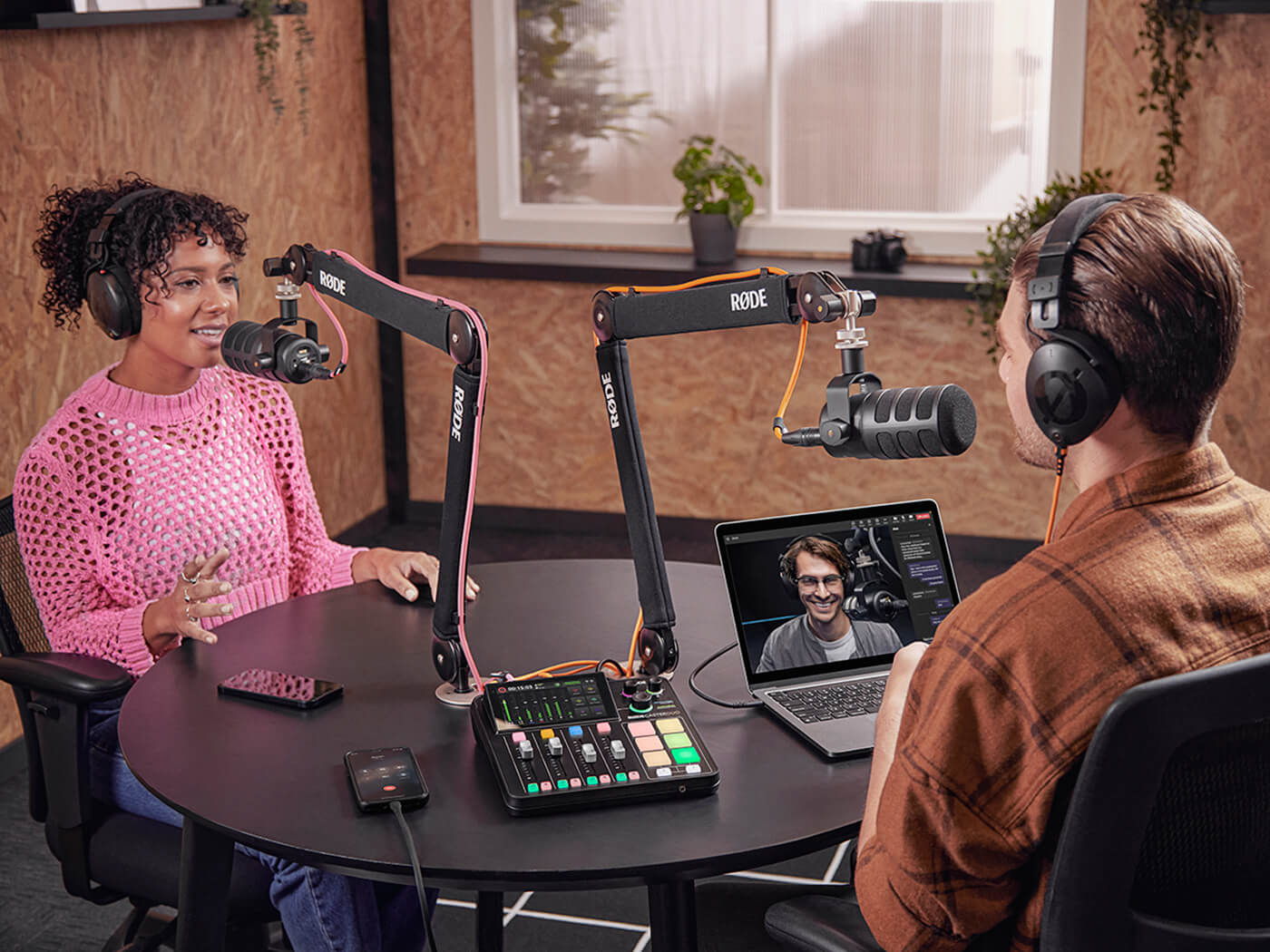
Key features
- Podcasting/broadcasting system with touchscreen operation, faders and pads
- Standalone operation or connect to computer (USB-C)
- Onboard recording to MicroSD or a connected USB drive
- 2 mic/line/instrument preamps with digital gain and presets for mic type/model
- Bluetooth input for music playback/taking call-ins
- Wireless receiver for up to 2 RODE Series IV transmitters
- DSP effects including noise gate, compressor, EQ, de-esser, exciters, reverb, voice transformation and master limiter
- 2 headphone outputs with individual level control/sensitivity selection
- 2 balanced line outs for connecting studio monitors
- 6 effect/sample/MIDI control pads with 3 switchable banks==
- Ethernet/WiFi network connectivity